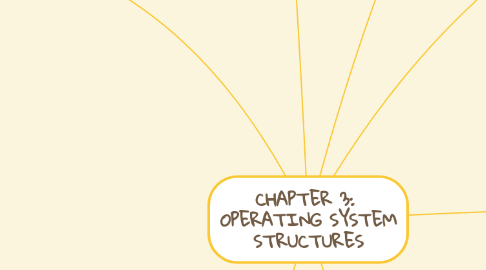
1. LAYERED APPROACH
1.1. In layered approach, the operating system is divided into a number of layers (levels), each built on top of lower layers. The bottom layer (layer 0), is the hardware; the highest (layer N) is the user interface.
1.2. With modularity, layers are selected such that each uses functions (operations) and services of only lower-level layers.
1.3. Advantage *Simplicity of construction and debugging
1.4. Disadvantages *The careful definition and interaction of the layers * Less efficient
1.5. Microkernel
1.5.1. Small operating system core
1.5.2. Contains only essential core operating systems functions
1.5.3. Many services traditionally included in the operating system are now external subsystems o Device drivers o File systems o Virtual memory manager o Windowing system o Security services
1.5.4. ADVANTAGES: *Extensibility o Allows the addition of new services * Flexibility o New features added o Existing features can be subtracted *Reliability o Modular design o Small microkernel can be rigorously tested *Portability o Changes needed to port the system to a new processor is changed in the microkernel - not in the other services
2. OPERATING SYSTEM DESIGN
2.1. Design and Implementation of OS not “solvable”, but some approaches have proven successful.
2.2. Start by defining goals and specifications
2.3. The design of the system will be affected by the choice of hardware and the type of system: batch, time shared, single user, multiuser, distributed, real time or general purpose
3. OPERATING SYSTEM DESIGN GOALS
3.1. User goals – operating system should be convenient to use, easy to learn, reliable, safe, and fast.
3.2. System goals – operating system should be easy to design, implement, and maintain, as well as flexible, reliable, error-free, and efficient.
4. OPERATING SYSTEM STRUCTURES
4.1. Input/Output operations
4.2. file-system manipulation
4.3. Error detection
4.4. User interface
4.5. Program execution
4.6. communications
5. ADDITIONAL OPERATION SYSTEM FUNCTIONS
5.1. Rsource allocation
5.2. accounting
5.3. protection and security
6. SYSTEM CALLS
6.1. System calls provide the interface between a running program and the operating system
6.2. Three general methods are used to pass parameters between a running program and the operating system
6.2.1. Pass the parameters in registers.
6.2.2. Parameters stored in a block, or table, in memory, and address of block passed as a parameter in a register
6.2.3. Parameters placed, or pushed, onto the stack by the program and popped off the stack by the operating system.
7. TYPE OF SYSTEM CALLS
7.1. Process control
7.2. file management
7.3. device management
7.4. information maintenence
7.5. protection
7.6. communications
7.6.1. message passing
7.6.1.1. communication takes place by means of messages exchanged between the cooperating processes
7.6.2. shared memory
7.6.2.1. a region of memory that is shared by cooperating processes is established.
